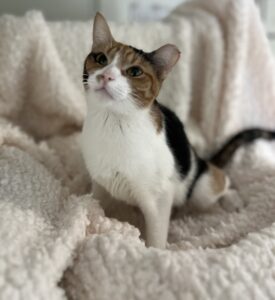Most of us know that cats are finicky eaters, but they can also be pretty picky when it comes to the other end of the digestive process—making use of a litter box. Medical issues are the number one reason cats avoid using their litter box, so make sure to rule out medical issues right away if you run into box avoidance. Otherwise, follow the below litter box tips, and you’ll have a happy kitty.
Location, Location, Location
While putting a cat box in an out-of-the-way spot to minimize odor and prevent cat litter from being tracked throughout the house may work for you, it may not be the best location for your cat. Loud appliances, cold floors, and other deterrents could give your kitty reason to not use the box. So you may have to compromise. The litter box should be kept in a spot that affords your cat some privacy yet is also conveniently located. If you place the litter box in a closet or a bathroom, be sure the door is wedged open from both sides to prevent her from being trapped inside or locked out.
Pick of the Litter
Research has shown that most cats prefer fine-grained litters, presumably because they have a softer feel. The new scoopable (clumping) litters usually have finer grains than the typical clay litter and are very popular. But high-quality, dust-free, clay litters are relatively small-grained and may be perfectly acceptable to your cat. Many cats are put off by the odor of scented or deodorant litters. For the same reason, it’s not a good idea to place a room deodorizer or air freshener near the litter box. A thin layer of baking soda placed on the bottom of the box will help absorb odors without repelling your cat, and odors shouldn’t really be a problem if you keep the litter box clean.
What’s the Magic Number?
You should have at least as many litter boxes as you have cats. That way, none of them will ever be prevented from eliminating in the litter box because it’s already occupied. You might also consider placing litter boxes in several locations around the house, so that no one cat can prevent the other cats from getting access. We also recommend that you place at least one litter box on each level of your house. It’s not possible to designate a personal litter box for each cat in your household, as cats may use any litter box that’s available, and that means a cat may occasionally refuse to use a litter box after another cat has used it. In this case, all of the litter boxes will need to be kept extremely clean and additional boxes may be needed.
Covered Litter Boxes
Some people prefer to provide their cats with a covered litter box, but doing so may introduce some problems. You may forget to clean the litter box as frequently as you should because the dirty litter is “out of sight, out of mind. A covered litter box traps odors inside, so it will need to be cleaned more often than an open one. A covered litter box may not allow a large cat sufficient room to turn around, scratch, dig, or position herself in the way she wants. A covered litter box may make it easier for another cat to lay in wait and ambush the user as she exits the box; on the other hand, a covered litter box may feel more private, and timid cats may prefer it.
Keeping It Clean
To meet the needs of the most discriminating cat, feces should be scooped out of the litter box daily. How often you actually change (replace) the litter depends on the number of cats you have, the number of litter boxes, and the type of litter you use. Twice a week is a general guideline for clay litter, but depending on the circumstances, you may need to replace it every other day or only once a week. If you clean the litter box daily, scoopable litter may only need to be changed every two to three weeks. If you notice an odor or if much of the litter is wet or clumped, it’s time for a change. Don’t use strong smelling chemicals or cleaning products when washing the litter box, as doing so may cause your cat to avoid the box. Some cleaning products are toxic to cats. Washing with soap and water should be sufficient.
Liner Notes
Some cats don’t mind having a plastic liner in the litter box, while others do. Again, you may want to experiment to see if your cat is bothered by a liner in the box. If you do use a liner, make sure it’s anchored in place, so it can’t easily catch your cat’s claws or be pulled out of place.
Depth of Litter
Most cats won’t use litter that’s more than about two inches deep. In fact, some long-haired cats actually prefer less litter and a smooth, slick surface, such as the bottom of the litter box.




